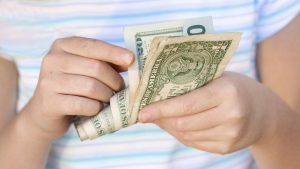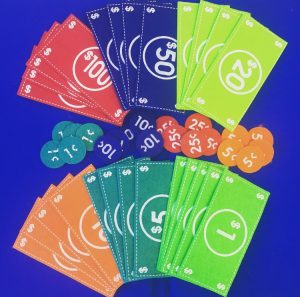Musical Math Fun: Addressing Functional Math IEP Goals

My Internship Experience

World Music Therapy Day
Hi everyone! Lyndie here and I’m super excited to be sharing today’s blog post. It’s been months (literally!) since I’ve done this so bear with me. By the way, thanks to all of my wonderful interns/employees for doing such a fantastic job with these blog posts! I love reading them and my clients of course love it when I use them!
Building functional math skills is one of the hardest IEP goals that I find myself making music interventions for. Maybe it’s because I’m not the greatest mathematician? One of my middle school classrooms requested a music game that could help with navigating the concept of adding smaller bills together to pay for something with a higher price. The requirements were that they wanted to be able to use it during table time, and it had to be musically simple enough that they could play it with the students when I wasn’t there. The great thing about this intervention is that I can also use it with younger students (working on identifying dollar bills or coins) or older students (using dollar bills and coins to hit the exact prices).
Similar to music jeopardy, I started with 4 categories: “Name that Song”, “Name that Singer”, “Finish the Lyric”, and “Name that Movie”. I made 5-6 cards for each category, wit h each category being represented by a different color. The original idea for color coding each category was because I used an old Twister spinner board to choose the category instead of the students choosing. I have a few that like to stick to either all $1.00 questions, or one category that they are good at. You can also just take turns and skip the Twister spinner (or maybe not everyone still has theirs from childhood? )
h each category being represented by a different color. The original idea for color coding each category was because I used an old Twister spinner board to choose the category instead of the students choosing. I have a few that like to stick to either all $1.00 questions, or one category that they are good at. You can also just take turns and skip the Twister spinner (or maybe not everyone still has theirs from childhood? )
- For the category “Name that Song”, the front side had a dollar amount, and the back side had a pair of headphones indicating that they should listen. All of the songs I chose for this category were familiar (think Sing, Trolls, Despicable Me, etc) but you can really change it up depending on what your students listen to. The “cheaper” cards didn’t have a time limit on the song, but the more expensive cards had a limit so they could only listen to 30, 15, or 10 seconds of the song before guessing.
- For the category “Name that Singer”, the front side had a dollar amount, and the back side had the name of the song and a pair of headphones indicating they should listen before guessing. I had one intuitive young man who asked me about rebates, so we adapted this category so that if they guessed the singer based only off of the name of the song and didn’t have to listen to it, could they have a dollar back. Hey, you roll with it, I’m just glad I knew what a rebate was!
- For the category “Name that Movie”, the front side had a dollar amount and the back side had the name of the song, the name of the original singer (i.e. Taylor Swift, not Rosita the pig), and a pair of headphones. For this category, I encouraged the students to try to sing the song themselves first and try to remember the name of the movie instead of defaulting to listening as the first clue.
- For the category “Finish the Lyric”, the front side had a dollar amount, and the back sides had the lyrics written in a different way depending on how “expensive” the card was. So, $1.00 cards for example had “Shake it ________” and a $18.00 card would be “I follow my heart ______ _______ _______”.
Depending on wh ich classroom I’m in, I occasionally have the students add up how much money they spent on correctly answered questions and do some kind of reward pertaining to choice making in the next activity. The teachers loved it because it was easy to use with recorded music, and they could make their own cards with new categories when I wasn’t there.
ich classroom I’m in, I occasionally have the students add up how much money they spent on correctly answered questions and do some kind of reward pertaining to choice making in the next activity. The teachers loved it because it was easy to use with recorded music, and they could make their own cards with new categories when I wasn’t there.
Thanks for reading! I hope you enjoy using this intervention in your classrooms. What are your favorite interventions that incorporate math IEP goals like money?
Lyndie Walker MT-BC | Owner and Clinical Director of Toneworks Music Therapy Services

